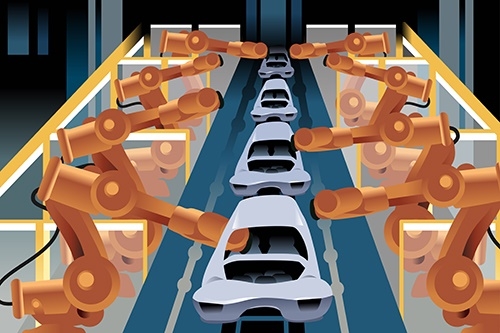
By Jason Krupp*
For public transit advocates wondering what form transport networks will take in a future increasingly concerned with urbanisation, congestion and energy efficiency, here is one probable answer: It will have four wheels, a small seat capacity and travel on the road. Yes, it is the car.
This is the view of the International Transport Forum, the OECD’s strategic transport think tank, which recently completed a detailed thought exercise on how to accommodate the 400 trillion trips that will take place in cities between now and 2050.
Just to complicate matters, 54 trillion of those trips will be new trips as the lure of cities draws people in from rural areas, particularly in Africa, Asia and South America. Many of these trips will be motorised, with the total number of cars globally expected to increase by 80% over the next 35 years, causing the total number of kilometres travelled by car to double or even triple.
That will present a major challenge for cities, especially as concerns over greenhouse gas emissions, pollution, congestion and use of urban space become more pressing.
The leap of faith that the ITF researchers took was to look at autonomous networked vehicles, which are only beginning to emerge out of the concept/testing stage of development and assume the technology is mature. They then divided the vehicle fleet into taxibots, small autonomous vehicles that operate on a ride sharing basis, and autovots, single passenger autonomous vehicles akin to taxis, and modelled the effects using real world trip data from a medium-sized European city.
The results were startling.
Exclusively using taxibots and high capacity public transport (trains), the model suggested that the transport network could deliver the same amount of mobility as today but with 10% of the current fleet. That means you could remove nine out of every 10 cars on the road, and still service the transport needs of a mid-sized European city. Even at rush hour, automated rideshare arrangements could still cope with existing demand using 65% fewer vehicles will not impact to service.
Adding autovots into the mix reduced the efficiency of the network, since it added single passenger trips to the mix, but the model showed it could still service the same number of trips with 44% fewer vehicles when coupled with high capacity public transport. Even removing trains from the equation still allowed the number of vehicles to be reduced by 23% with no impact on service.
Both scenarios significantly reduced on-street parking requirements, with top-end estimates suggesting that about 1.5 million metres could be recouped, equivalent to 210 football pitches. This is space that could be freed up for pedestrian walkways and bike lanes, or for commercial and public use. Off-street parking requirements also decreased substantially in the model, releasing the equivalent of 170 football fields of space.
The efficiency gains also extended beyond the network. The report notes that cars spend most of their useful life standing idle. But by giving up the concept of car ownership as we understand it now, vehicle usage is projected to increase from 50 minutes a day to 12 hours, while distances travelled per vehicle will increase from 30km to 200km.
Admittedly the ITF report is just a modelling exercise, but it does pose some interesting issues that need to be considered right now.
Public transport is one such area. The ITF’s model was most efficient when it included high capacity public transport, but the researchers note that these expensive and risky investments could be entirely replaced by the addition of 4500 autonomous vehicles to a network.
This may not affect cities like Auckland and Wellington that have already invested in rail, but could provide an alternative for those urban centres that are considering expanding their public transport networks. Indeed, the authors of the report note that many forms of public transport that are in use today, such as light rail and buses, could be completely replaced by autonomous fleets.
Furthermore, the projected efficiency gains are contingent on a modern roading network. This does not necessarily mean expanding the network, but continual investment in efficiency-maximising measures will be needed.
Of course, the report should be taken with a pinch of salt since it skips all the difficult and messy change that needs to take place before we get to the utopian future outlined by the ITF. However, it underscores the need for transport planners to look through the technology options and limitations they face today when making long-term decisions to ensure we are not unnecessarily constraining future innovation.
It also places a significant responsibility on the shoulders of politicians, who will not only have to put a regulatory framework in place before autonomous vehicles can become a reality, but sell these ideas to a public that increasingly views cars as a transport mode that other people should give up.
As with all disruptive technologies, the road to a fully autonomous transport network will not be smooth, and there will be bumps and potholes aplenty. But if the ITF thought exercise is to be believed, it will be all worth it once we get to the final destination.
-------------------------------
*Jason Krupp is a research fellow at the New Zealand Initiative. This is this week's NZ Initiative weekly column for interest.co.nz.
2 Comments
Cannot be far away given the advanced state of open source software to conduct autonomous flight employing toy drones. View local simulated trial survey manoeuvres.
SkyProwler - VTOL UAV
We welcome your comments below. If you are not already registered, please register to comment
Remember we welcome robust, respectful and insightful debate. We don't welcome abusive or defamatory comments and will de-register those repeatedly making such comments. Our current comment policy is here.